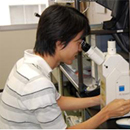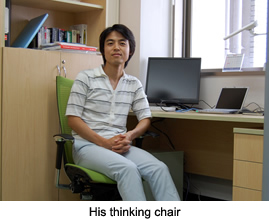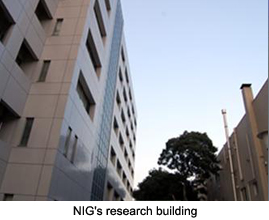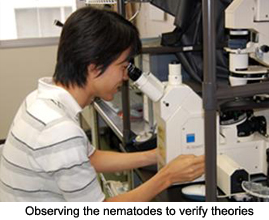KIMURA, Akatsuki D. Sc., Associate Professor

Cell Architechtonics – a new way of looking the cells
Assoc. Prof. Akatsuki KIMURA uses an ergonomically designed chair and is interested in robotics and architecture. Looking at a product designed to maximize its functionality, he wonders why this shape enhances functionality, why this design is the best. He also looks at living things focusing on their forms and come up with more new questions.
- Curiosity about form and function
 He was asking himself what he wanted to do with his life when he was a college student. Then he got intrigued by what was written in a book by an architect. It said that a city functions as a whole from a bird’s-eye view, although it is not planned that way or locally it is owned by individuals. Geographical limitations give rise to certain regularity.
He was asking himself what he wanted to do with his life when he was a college student. Then he got intrigued by what was written in a book by an architect. It said that a city functions as a whole from a bird’s-eye view, although it is not planned that way or locally it is owned by individuals. Geographical limitations give rise to certain regularity.- He wanted to find out rules behind order or function defined by formal or spatial conditions. He felt that that was a new issue he was being called to tackle.
- A human being as a complex form of life is an assembly of individual cells. While general attention is placed on the structure or function of individual molecules that make up a cell, Dr. Kimura focuses on how the form of a cell, an assembly of materials, is determined and realized.
- His approach to the relationship of cellular form and function is that of a new discipline, Cell Architectonics, which aims at understanding the design principles and dynamics of cell formation, that is, elucidating how organelles are arranged at appropriate places to perform their functions, likening a cell to a spatially constructed building.
- Approach of Cell Architectonics
 Dr. Kimura started his work in Cell Architectonics by asking questions. How strong is cytoskeleton, the steel frame of the “house” called cell? How much dynamic load is applied during cell division? Scientific knowledge has been accumulated about individual molecules that constitute a cell. However, not much is known about the cell as a whole. For example, no reason has been found to explain the phenomenon that is almost taken for granted: the central location of the nucleus in a cell.
Dr. Kimura started his work in Cell Architectonics by asking questions. How strong is cytoskeleton, the steel frame of the “house” called cell? How much dynamic load is applied during cell division? Scientific knowledge has been accumulated about individual molecules that constitute a cell. However, not much is known about the cell as a whole. For example, no reason has been found to explain the phenomenon that is almost taken for granted: the central location of the nucleus in a cell.- He formulates hypotheses, performs simulation with known values and compares with observations of actual cells. At present, his research is focused on cellular movements and their mechanisms. One research goal is to visually record the movements of the nucleus and all other intracellular movements and share them with researchers the world over.
- Research attitude shows the researcher’s way of thinking
- Dr. Kimura believes that it is important to maintain balance between the abilities to formulate questions and find answers. Today, many students and postdoctoral researchers are becoming weak in their ability to formulate questions. This is why the NIG expects much from the question-setting ability of Dr. Kimura, who explores a new research area.
 What good does this research do? He has been asked this question numerous times. To be sure, Cell Architectonics is not directly related to solving medical problems or health issues. It does fulfill intellectual curiosity, which is at the core of research. It may become possible to apply research findings about the relationship between natural form and function to engineering.
What good does this research do? He has been asked this question numerous times. To be sure, Cell Architectonics is not directly related to solving medical problems or health issues. It does fulfill intellectual curiosity, which is at the core of research. It may become possible to apply research findings about the relationship between natural form and function to engineering. - “I have never had confidence since the beginning, not even now. But if you have to wait until you become confident, you can’t do anything,” says Dr. Kimura. So he musters up his courage to present his views and get feedback from others. “The more unusual ideas you have, the more severe criticism gets. But you must accept such criticism to move forward.” As a boy, he was a good pupil who never dared to rock the boat. He was transformed by his superviser in the graduate school. “What do you think?” the professor asked the student, and this led the student to develop his abilities that made him a full-fledged researcher. A researcher’s way of thinking shows in themes and approaches chosen. “You start out as transparent, and your encounters with many different people give you colors. What kind of people you meet may be most important in your life.” He hopes to express his world view in his own way while getting influence from others and influencing others in turn.
- (Interviewed by Leave a nest Co.,Ltd on Sep. 10, 2007)footer















